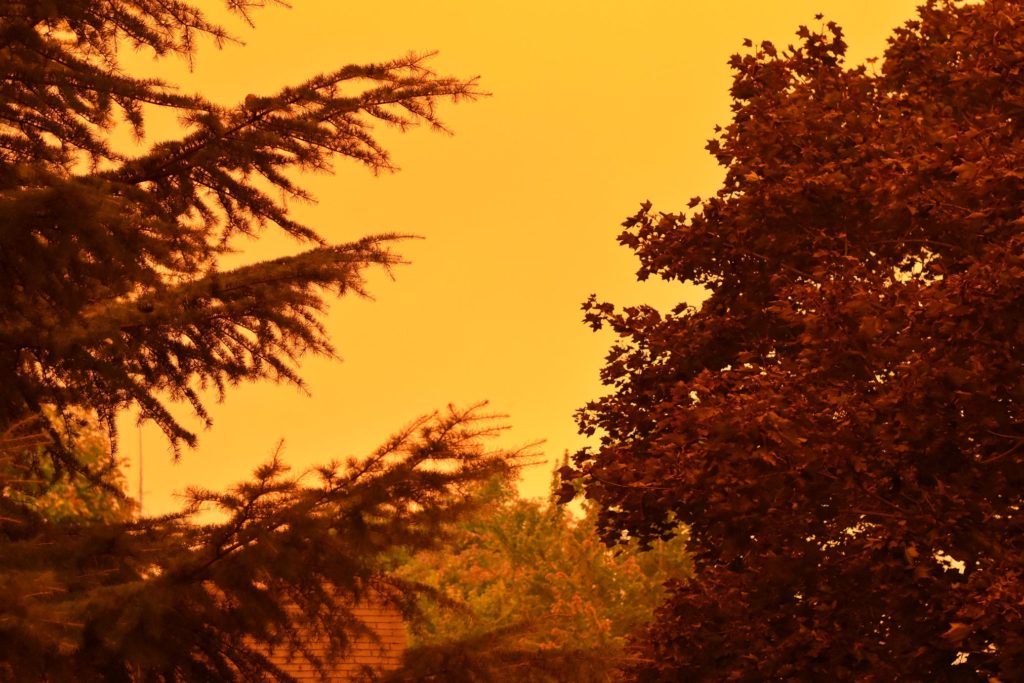You may think that using or keeping native plants in your landscape automatically poses a fire hazard. They don’t. They are not “made to burn” as some have said. Many are drought tolerant and better at holding moisture in their foliage, making them less prone to burning.
Since plants are what burns in a wildfire, when it comes to protecting our landscapes and homes, there are several factors to address to improve fire safety.
You may want to clear all your land to keep your property safe from fire. But that cleared space invites weedy plants that need more maintenance to keep up with—weeds like Scotch broom, annual non-native grasses, and star thistle—and are even more flammable.
And we’re in a megadrought, so there isn’t enough water to keep sprawling lawns and moist vegetation in the 30 ft. defensible space zone.
California is one of the most biodiverse places on earth. The plants that evolved here are naturally suited to periods of drought. Periodic fire is part of the natural landscape, too. Many plants resprout after being burned so they can establish quickly and to help keep hillsides protected and stabilized. And seeds of some plants need fire to germinate.
Native plants evolved with insects that feed on only native foliage which in turn feed birds and many other animals that are a part of our ecosystem. Without them our ecosystem weakens and can collapse—fewer insects, birds, fish, small and then large animals. And that means, to me, a lower quality of life forever.
So we must aim for greater fire resistance in our landscapes and including native plants preserves our ecosystem and the beauty that brought us all here in the first place.
There are three elements that play a greater role than plant selection.
These are plant and landscape maintenance, irrigation, and spacing plants and landscape elements for a more defensible landscape. Plant selection comes after these. The condition and environment the palnts are in contribute much more to the flammability of any plant.
Pruning, thinning, and deadwood removal are a must.
Dead plants, dead branches, and dead leaves should be removed. Leaves and pine needles on the ground should be removed and carried to the green waste. Or better, chipped or shredded and added to compost piles to be used as mulch when they’re broken down. Or apply during the rainy season (should we have one again) so they can get packed down close to the soil. (See my previous article on mulch flammability.)
Irrigate regularly, not often.
Maintain a regular watering schedule to keep plants hydrated. For a drought tolerant landscape, especially with well-chosen native plants, this can be as little as two times per month. A deep watering session and mulched soil (see that previous article on mulch and flammability) and you can keep an attractive landscape that benefits birds, bees, and other wildlife of the region and uses little water.
See the calscape.org/planting guide and read the Watering New Plants section for excellent information on how to establish new native plants and how they may deal with no supplemental water once they’re established.
Spacing plants for a more defensible landscape
Starting at the house, keep all flammable materials and all plants at least five feet away from it.
From 5-30 ft. from the house, a rule-of-thumb is to space shrubs at least twice their height from each other. Further away you can plant clusters of trees and shrubs with at least 10 ft. from each other. The point is to break up continuity of vegetation while keeping a small plant community for better root growth and maintaining wildlife habitat. It’s prettier, too.
This is very basic. But here is one resource I’ve found informative: grassrootsecology.org.
Some native plants are more fire-resistant.
No plant is fire-proof. And the fire resistance of any plant can vary with its environment and care. Looking through lists of fire resistant plants can be frustrating, many give conflicting answers. Researchers say that very few plant lists are actually tested, mostly because the greatest factors are the condition and the environment the plants are in. And that many lists are copied from each other, so misinformation abounds.
With that said, here are a few native plants that are proven, somehow, to be fairly fire-resistant. The first is an example of a confusing one.
Manzanita is on many lists, both fire-hazard and fire-safe. It includes the large white-leaf manzanita shrub as well as the low-growing ground cover types. This one comes from reputable sources and it dispels the commonly held idea that manzanita is a fire hazard. In a home landscape they can be maintained as described above and be fire-safe. (I will accept valid differences of opinion on that.)
Other natives that are good are Toyon (Heteromeles arbutifolia), Coffeeberry (Frangula californica), the gooseberries and currants (Ribes species), western redbud (Cercis occidentalis), Oregon grape (Berberis aquifolium), and a nice ground cover is creeping sage (Salvia sonomensis).
Home-hardening is most important.
It’s been shown that up to 60% of burned houses are ignited by embers from up to 100 yards away, and not so much from landscape plants. This means that protecting your house from ember starts may be most important. You can find more information on home-hardening from grassrootsecology.org, see the Home Hardening section.
There’s no guarantee that all efforts to protect your home and outdoor spaces can prevent you from loss, not with the ferocity of the fires we’ve been seeing lately. But all measures can stack the odds in your favor.
Do consider native plants for your landscape, they do fit in to a fire-safe landscape. Get them in and put them on a good water-wise irrigation regimen, do regular maintenance (it’s much less than hacking down Scotch broom and thistles), and enjoy the wildlife, the fragrances, and the beauty your little part of California has to offer.
Calscape.org is your detailed guide to help you select species. You can find that mulch and flammability article here.

